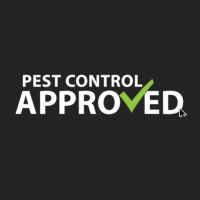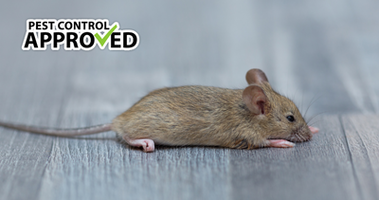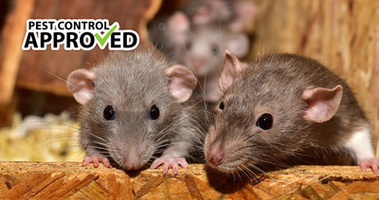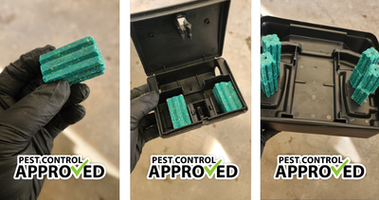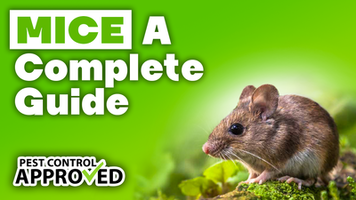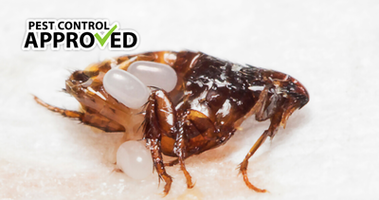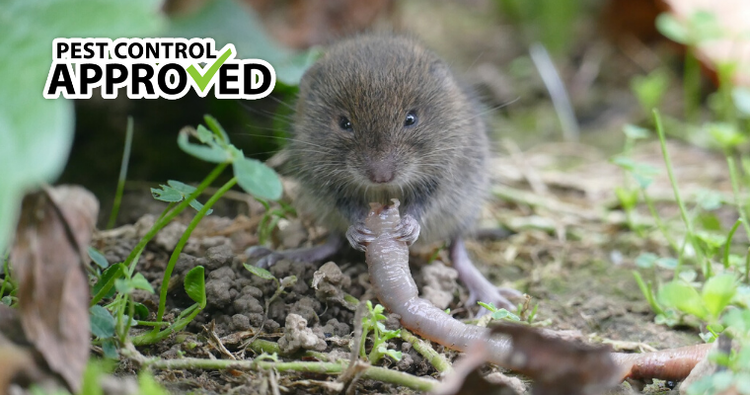
What are Voles?
Voles are stocky rodents, belonging to the subfamily Arvicolinae in the family Cricetidae. These are small furry rodents like mice are found abundantly in North America. They have a grayish-brown color, relatively small eyes, flattened ears, and a blunt nose with stocky and rounded bodies. Voles have longer fur and shorter tails than mice although the two rodents are often confused due to their similar appearance.
They can be found throughout North America in dense grassy fields, meadows, gardens, woodlands, near lakes and rivers, and in agricultural areas. They make their nests just below ground level. Their tunnels can extend under up to 1.5 acres of land. Voles use these tunnels to store food and to protect their young. Some of them are nocturnal while others are diurnal, or active throughout the day. They remain active throughout the year and build burrows under the snow.
Voles are not indoor rodents like rats. They mostly remain outdoors, creating dozens of interconnected tunnels. Their tunnels cause the plants and greenery to die or turn pale due to lack of nutrients and root-picking. Voles do not bite human beings or pets. But their presence can be dangerous. Their feces and urine can harbor disease. Its important to know How To Properly Clean Rodent Droppings.
One of the most prolific breeders in the rodent family, voles can produce 5-6 litters per year with 6-10 young per litter. A mating pair in your garden can quickly produce a large population soon. Young voles reach sexual maturity after three weeks of gestation.
Difference between Voles and Moles
Moles are often confused with mice, moles, and shrews. Below is a guideline to help you differentiate between moles and voles. Use this guide to determine which pest you have.
Voles Physical Appearance
- Visible Eyes with flattened nose
- Blunt snout
- Short tails and legs
Diet
Voles are herbivorous mammals. They feed on plants, grass, roots, tree bark, and seeds. They will eat insects if they cannot find other food.
Habitat
Voles create shallow, snake-like tunnels through the soil, often under lawns, under the ground to search for the food. The entry and exit points of these tunnels are like the size of a golf ball. They do not create heaps of dirt while burrowing tunnels. The tunnels are mostly interconnected.
Moles Physical Appearance
- Nearly invisible eyes
- Pointed Snouts
- Large paws for digging
Diet
Moles are carnivorous, which means they feed onto insects present in your yard. These are predatory creatures and prey on earthworms, pill bugs, beetles, grubs, centipedes, millipedes, or any other arthropod they find in the grass.
Habitat
Moles make tunnels under the ground, which sometimes are deep. The depth of tunnels shows the voraciousness of moles, which delve deep into the ground to find insects. They create mounds of dirt in the yard at their entry and exit points.
Common Types of Voles
There are about 50 species of voles. Most of them are included in the genus Microtus. We are mentioning some of the common types of moles here.
Meadow Voles
Meadow voles are the most abundant vole in the Canada and United States. They mostly live on open land such as grassy lawns, woodlands, wet meadows, disturbed forests, and damp areas like marshes. In Alberta, they commonly inhabit hayfields. They are adept swimmers and have a good sense of hearing and smell. In Canada, meadow voles are most active around dawn and before dusk. Although they are considered a pest, they are an important participant in ecological system, being a food source for many larger predators and helping to spread fungi.
Woodland Voles
Woodland voles are abundant throughout North America. They usually measure less than 10 cm (4 inches), which makes them one of the smallest species. They live in forests, around leaf litter. The availability of food allows them to thrive as a species and reproduce abundantly.
Water Voles
These voles are most commonly found around wet and moist areas such as the edges of streams, damp ditches, and embankments. They are also active in grassy areas and orchards, where there is a significant amount of young plants or saplings. They are excellent swimmers and do not hibernate; they spend winter searching for food.
Prairie Voles
As the name suggests, these voles inhabit in large open areas. This characteristic makes golf courses, lush green lawns, and pastures their favorite inhabiting places. They have long greyish-brown hair and a yellower belly. They are easily startled and prefer drier habitats.
Vole Behavior
Voles exhibit human-like social behavior. They can live in large colonies of up to 300 voles. The younger ones live under parental care until they mature. Voles are monogamous and the mating pair has a strong social bond.
They have great hearing and sense of smell and communicate via chemical signals and scent. They produce quiet and sharp squeals for communication.
According to research done in 2016, voles take care of their colonies. They care for mistreated or injured companions. This displays their social integration and reliance on each other.
Do Voles Hibernate in Winter?
Many animals and rodents hibernate during winter, but voles do not. They are active underground and continuing their activities throughout the cold months. Their activity under the ground is masked by snow.
The only sign of voles during winter is through runways between two tunnels. These runways are about two inches wide with snow nearby . They store their food in their tunnels and sleep excessively to conserve for the energy.
Do Voles Bite?
Rodents are famous for biting people, contaminating food, and making a mess in your kitchen. Voles are generally not aggressive and do not bite humans until they are provoked. They do not even attack cats or dogs.
This does not mean that they are innocuous creatures that coexist in your yard. Research suggest that they are active carriers of many diseases such as rabies, Lassa fever, and Lymphocytic Chorio-Meningitis (LCM). These diseases are not only spread through bites, but physical contact with the rodent or their urine, and droppings.
How to Get Rid of Voles?
Voles are a problem for many farmers, gardeners, or lawn growers. You can be unaware of the presence of voles in your yard until the plants in your yard are unable to grow. You may want to look into steps to prevent or remove voles.
1. Natural Remedies
It is always good to try natural remedies before you spend money on store bought remedies. If these simple remedies do not work, you may want to content pest control professional or purchase professional grade products. We discuss some of the most famous and well-known remedies for you in the following guide:
Castor Oil
Every artificial vole repellent has castor oil as an active ingredient. You can buy a bottle of castor oil from your nearby drugstore. It is cheaper to prepare your own castor oil spray than buying an expensive one from the store. Mix one part of dish soap and one part of castor oil, then add this mixture into one gallon of water. Put it a spray bottle and spray in your yard and near the entry and exit points of vole tunnels.
Garlic
Garlic, like castor oil, acts as a vole repellent due to its pungent smell. Drop a few cloves of garlic all around your garden or prepare a spray by adding properly minced garlic into water. This spray can be really useful and organically repel voles. Check out the Bare Ground Sprayer & Garlic Mixture.
Attract a Predator
Predators can be another useful way of containing the vole population and ultimately in wiping them out. If you have voles in your garden or yard, then pets can be of much use in this regard. They will prey on the voles and ultimately will thin out their population.
Another way is to attract owls. Owls are nocturnal birds and great predators. They can easily eliminate a vole population.
Coffee Beans
Coffee beans are also helpful. You can recycle your coffee beans while simultaneously using them for pest control. Spread coffee grounds all over your yard, and these creatures will avoid it. You can use this strategy in combination with trapping.
Pet Waste
Just as humans despise pet waste, so do voles. In order to limit their movement, put pet waste (cat, dog, or other predator) near their entry and exit points. This is a natural, if smelly, way to deter them from your outdoor space.
Noise
Studies suggest that voles, moles, and gophers are highly sensitive to sound and can’t tolerate loud noises. You can use wind chimes or ultrasonic sound emitters in your yard to repel them. Depending on the yard’s size, you may need more than one. Sonic Spikes can also work to help reduce rodent and vole activity in yards.
You can also use a radio or any other noise creating a machine for this purpose. Make sure you do not create so much noise that you annoy your neighbors.
Scents
Some natural scents can be useful in deterring voles. Rodents do not like fishy scents, and it can act as a natural deterrent. If you have some leftover fish, place it near the entry and exit points of vole tunnels. The stinky scent can play a role in keeping them at bay. Be careful, it could bring other pests into your yard like skunks or stray cats. Pro-Pell Rodent Repellent is a good method that helps reduce activity when properly applied around your property.
2. Vole Trapping
Trapping is a highly effective strategy. You can find traps specifically designed for voles in the market, but you can also use a mousetrap. CLICK HERE for a list of effective traps for rodents and Voles.
You can also use live traps consisting of one or two spring-loaded doors. The live voles must be released far from your yard to prevent them from returning.
Strategies to Use a Trap Effectively
- Instructions: It is vital to look through the instructions. They will recommend placement and show how to use the traps effectively.
- Placement: You should place the traps where voles are frequently seen. This will ensure that the trap receives a lot of traffic.
- Baiting: As voles are herbivores, you don't bait the trap with meat or meat products. They are fond of eating nuts, fruits, seeds, or plants. You can even use peanut butter!
- Precautions: If you are setting up a trap, then make sure it is out of reach pets and children. A mouse or vole trap can easily break bone.
- Checking the trap: Be sure to check the trap every day. If you’re using a kill trap, make sure to dispose of the body as soon as possible. If you do not remove it quickly, it may attract predators or breed disease. If it’s not a kill trap, then you should release the live vole far from your property. Make sure you are wearing gloves while checking traps.
3. Vole Poison
If the natural methods do not produce results, poison may be required. Whenever you are using poison, you should be extra careful. Make sure to keep children and pets away from the area. Talon Weatherbloc XT Rodenticide is a great product as the blocks are more resilient to exterior weather conditions compared to other rodenticides on the market. Make sure to ALWAYs read the chemicals label and MSDS sheet ensuring the poison is applied following laws based on location.
Poison can also affect your plants. Avoid using poison on rainy days as it can get washed away. Keep the poison near the pathways, entry, and exit points of tunnels. Try to inject it inside their tunnel, if possible. Poison might take some time to show results.
Getting Professional Help for Extermination
If the voles become uncontrollable, professional help may be required. Make sure you ask questions when you are hiring a professional rodent control company. Ask whether the professional or trained personnel can identify the voles from other rodents. Correct identification will lead to correct treatment. The company will provide its services after correct identification and provide you with some guidelines to follow. The time frame of the treatment depends on the population of voles in your yard, the size of your yard, and weather conditions.
A reputable company will also provide you with a list of suggestions, which you should follow after the treatment. They will also guarantee their service if voles return.
How to Prevent Voles from Returning
Once you have eliminated the voles, you should take steps to prevent them from returning. Here are some tips on how to prevent voles from inhabiting your yard.
1. Prevention
As the saying goes by, prevention is the best medicine. Keep an eye out for voles returning to your lawn. Regularly inspect your lawn, yard, or farm. To inspect your yard for voles, you need a pair of closed-toed shoes, a flashlight, and a pair of gloves.
- Survey: You must walk around your property and with the help of a flashlight, look out for the presence of voles. If you see any tunnels or runaways, then take adequate steps to remove them.
- Inspection: You should inspect greenery present in your yard. Look for nibbled on plants, plucked up roots, and gnawed tree barks.
- Observe: Look at the rodent’s physical appearance. Focus on its distinguishing features like blunt snouts and stocky bodies.
- Plan: Once you are know that you have voles, devise a plan for eliminating the problem. This often involves multiple strategies such as trapping and poison.
2. Fencing
Fencing can help prevent voles from entering your property. A fence around your property should be around 5.4 meters (18 ft) high and 30 centimeters (1 ft) underground to completely block their entry.
Getting a fence around your entire property can be a cumbersome and expensive task. However, you can embed smaller fences around your plants, vegetation, and trees.
3. Gravel
Another method to eliminate voles is to make conditions unfavorable for their survival. If you mix up gravel in your soil, it can deter them. Moreover, you can also save your plants from being devoured by placing a layer of gravel around them.
4. Promote a Dry Yard
Voles get into your garden and live there by making tunnels in soft and moist soil. You can use a few simple tips to keep your yard dry, clean, and vole free.
- Keeping your soil dry without hampering the growth of your garden life.
- Water the soil in the morning so that it dries out during the day.
- Trim the weeds around trees so that sunlight can reach them.
- Try to smooth all the dips in your yard, and with the help of a lawn roller, make it even.
5. Proper Entrance Covers
The ventilation holes and other necessary openings can provide an easy gateway for voles to enter your house. The openings of your chimney and other ventilating spaces should be covered with screens.
6. Cleaning Up Your Yard
The presence of mulch and dried leaves can be a huge attraction to voles. They love to devour dry leaves and enjoy ground covering that helps them move undetected.

